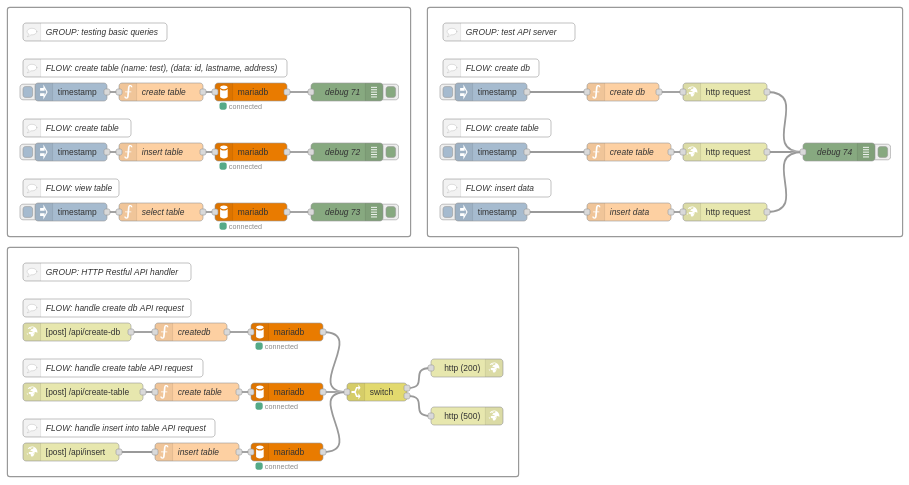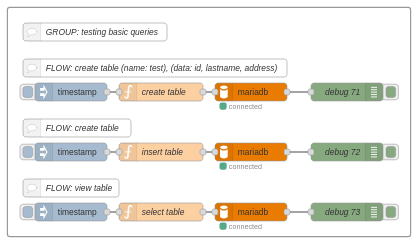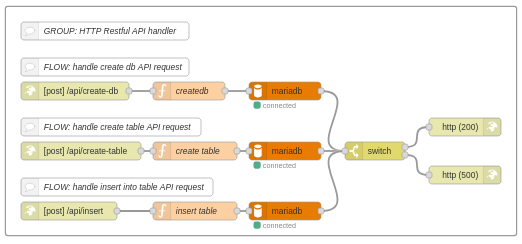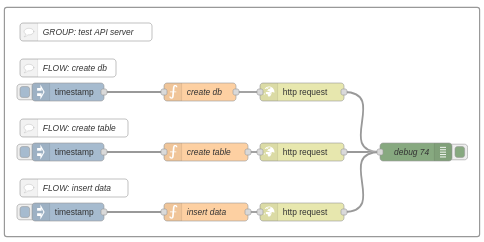MariaDB API example

This project demonstrates a minimal API server that retrieves data from a MariaDB database.
Control the project by either pressing the Inject buttons in the Node-RED flow or calling its HTTP endpoints; both options run the same flows and give full system control.
Services Used
-
MariaDB – MYSQL Database
Built using the Sandbox Node-RED flow structure. (TODO: Add reference for more details).
List of used nodes
-
Inject/Timestamp – Triggers flow execution
-
Function – Adds custom logic using JavaScript
-
HTTP Request – Sends HTTP requests to external services
-
Debug – Displays messages in the debug console
-
Switch – Routes messages based on conditions
-
HTTP response – Returns response to sender of HTTP request
-
mysql - Imported node from installed package, used for executing passed queries
| For details, see Node-RED Documentation |
GROUP: Test basic queries

This group checks that the MariaDB node (from node-red-node-mysql) works as expected. The three flows run a basic CREATE → INSERT → SELECT cycle.
FLOW: create table
Runs a CREATE TABLE statement.
Generic pattern:
CREATE TABLE IF NOT EXISTS demo (
id INT AUTO_INCREMENT PRIMARY KEY,
name VARCHAR(64),
qty INT
);GROUP: HTTP Restful API handler

This group turns the flows into a tiny REST service with three endpoints. Each flow maps one HTTP route to a MariaDB query. The MariaDB node returns a result object that includes msg.payload.affectedRows and, on error, msg.error. The flows use this information to set the HTTP reply:
-
200 query ran and affected the expected rows
-
4xx / 5xx validation failure or database error
Flows in the group are using HTTP-request node. Read more about the use of node here: … (TODO: add documentation)
FLOW: handle create db API request
POST /api/create-db
Body JSON:
{ "name": "my_database" }Function Node is used to then create query:
CREATE DATABASE IF NOT EXISTS my_database;Returns 201 when the database is created or already exists.
FLOW: handle create table API request
POST /api/create-table
Body (JSON): key name is the table name; every other key–value pair is a column definition:
{
"name": "demo",
"id": "INT AUTO_INCREMENT PRIMARY KEY",
"item": "VARCHAR(64)",
"qty": "INT"
}The function node builds and executes
CREATE TABLE IF NOT EXISTS demo (
id INT AUTO_INCREMENT PRIMARY KEY,
item VARCHAR(64),
qty INT
);Responds 201 on success.
FLOW: handle insert into table API request
POST /api/insert
Body (JSON): key name is the target table; other keys are the column names with their values:
{
"name": "demo",
"item": "widget",
"qty": 42
}Strings are automatically wrapped in quotes; numbers are left as-is. The resulting query for the example above is
INSERT INTO demo (item, qty) VALUES ('widget', 42);Returns 200 and the number of affected rows, or 400 if required fields are missing.
GROUP: test API server

This group contains three client flows that exercise the REST endpoints defined earlier. Click the Inject button in each flow to send a request; a Debug node then shows the HTTP response and status code in the sidebar.
Flows in the group are using HTTP-request node. Read more about the use of node here: … (TODO: add documentation)
FLOW: create db
The Function node builds the request for `POST /api/create-db.
msg.payload is a JSON body with a single field:
{ "name": "my_database" }